Land really is the best art.
I think having land and not ruining it is the most beautiful art that anybody could ever want.
—Andy Warhol
The new year is a good time to look back before looking forward: this blog offers opportunity to take stock of 2014, which was indeed a seminal year for Landlife. Landlife started out as a pioneering urban wildlife group in 1975, and founded the National Wildflower Centre as a UK Millennium project in 2000. I’ve grown with them for over twenty of those years in Liverpool—a global port with close historic connections to New York City—which has undergone dramatic growth, decline, and cultural resurgence . There is currently a major UK retrospective of Andy Warhol at Tate Liverpool, and it reminded me of his perhaps surprising quote above. Placing nature in the equation of the way people and places respond to change and circumstance is a real measure of resilience, something which urban ecologists are increasingly acknowledging and building into their practice. It is also about passing and sharing experience, and the creative spark of how to retain and get the best from any given situation.
In February 2014 I was invited to Nantes in NW France to participate in a cross-sectoral roundtable event with renowned designer Thomas Heatherwick, British Council France and a group of northern artists, ecologists and researchers. Another Atlantic-facing port city, Nantes’ year as European Green Capital in 2013 boosted the investment and usage of green spaces and energy-efficient transport, which together with massive public investment in the arts have made this city a buzzing centre for creative professionals, public art and, more recently, cultural tourism. Nantes has embraced the Loire, its gateway to the West, with inventiveness second to none, and is well worth visiting, especially if or when Heatherwick’s ferry will be carrying passengers daily.
Heatherwick’s Seed Cathedral was the chosen British Pavillion, which won the No.1 design award at the 2010 Shanghai World Expo. Seeds are Landlife’s daily bread, as, working with co-operative local farmers, we have successfully created a new seed industry on Merseyside. Seeing the thousands of glass rods from the dismantled seed cathedral made a big impression on me. Each of the 66,000 rods contained a seed from Kew’s Millennium Seed Bank, where I took Chinese visitors from Chengdu (one of the world’s fastest growing cities) in July 2014.
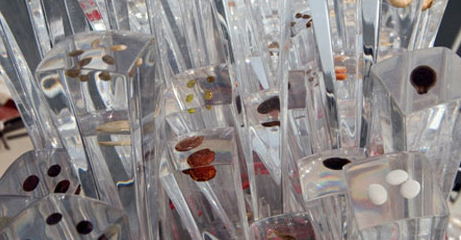
Though such seed banks may be valuable, Landlife believes that beauty and liveability lie in releasing their potential, and unlocking public space to create living seed banks, even in the world’s most densely-populated cities, like New York, Hong Kong and Chengdu. We have thus been able to bounce off some of this creativity and link it back to creative conservation projects in China, and help liberate seeds from the Chinese National Seed Bank in Kunming, which originally supplied seed for the cathedral. To this end we have already initiated special new wildflower seed industry in China, and surprisingly fronted British Week in Western China by signing a special Memorandum of understanding at the opening ceremony in Kunming.
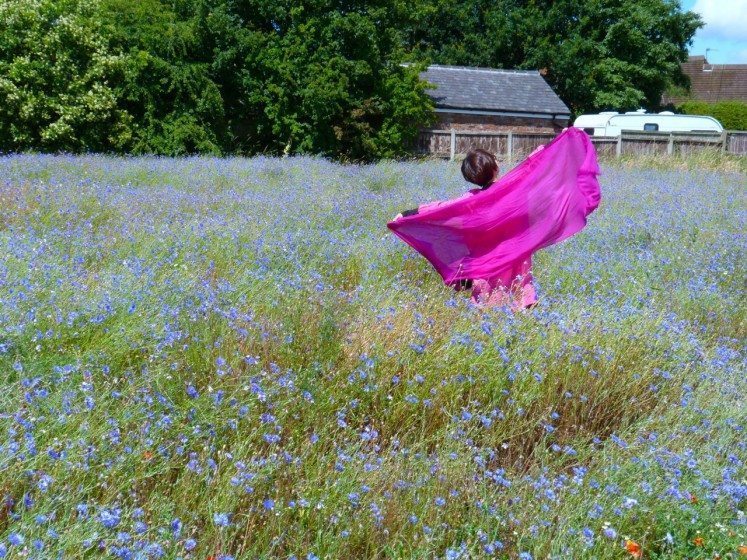
As well as fields, spaces in waiting are exciting for their own spontaneous nature, and we can inject a little rhythm with deliberately sown and tended seed for the joy of the evolutionary dance.
Liverpool has the oldest Chinese community in Europe with whom Landlife has a longstanding friendship. Last year, we brokered a deal between the progressive development company Urban Splash, Liverpool City Council with funding from John Swire & Sons Ltd, who have built their international business portfolio from Liverpool roots with the Latin motto which translates as ‘To be, rather than to seem to be’. The Tribeca Lands (named after the New York City neighborhood) is 3 hectares of vacant land below Liverpool’s Anglican cathedral. The project was in effect was a simple cultivation exercise and we made our own community splash by sowing with local children, and Chinese elders.

We sowed the areas with the glorious red poppy which had evocative connections in different ways, in England for its connection to memories of the first world war and its poignant centenary. But for many—both in the Chinese community and passers by—it was the pure joy of the unremitting red.
The sites flowered for the first time and looked fantastic from May through to July. The poppies were complete surprise to many people, and the sense of mystery added to the magic, proving that curiosity in projects can be an advertisement in itself, and signage is not always needed.
Despite some July rain, we were able to link it to an event we staged at the Liverpool International Business Festival with an event called Seeding Tomorrow, which for some was the best event of the business festival, and formalised our seed links to our Chinese colleagues from Kunming and Chengdu, as well as strengthening links with our French colleagues from Nantes. The event was chaired by Peter Thoday who was the Eden Project’s first horticultural director. The effect of the poppies still ripples on after the flowers have long gone—but they will be back for at least another two summers maybe three and guarantee a longer-term future for clever and hopefully coordinated cycles of land projects in Liverpool, which can easily combine food growing, artistic uses (a drive in Cinema on one Liverpool vacant plot) with wildflowers and nature.
Our philosophy is to place good applied ecology in the centre of places in flux. Temporary spaces may be short-term, but they can be a great addition to the vitality of any city. This can combine of course with longer term projects ideals, but gives a greater and rich landscape spectrum as a result.
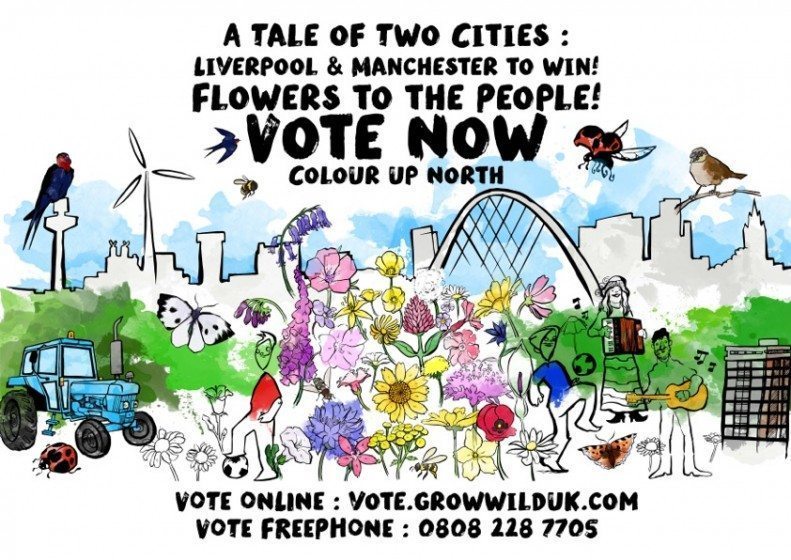 I am pleased to report after a successful harvest, our year culminated in a successful campaign to win, the wildflower Landmark/flagship bid for England, organised by Kew Gardens, as part of their National Lottery-funded programme called Grow Wild. After winning through a series of competitive rounds the result was finally decided by public votes over a one month period. It was an award we were very proud to win for Liverpool and Manchester after generating over 19,000 votes. We’re humbled by international support from China, India to Afghanistan and the United States.
I am pleased to report after a successful harvest, our year culminated in a successful campaign to win, the wildflower Landmark/flagship bid for England, organised by Kew Gardens, as part of their National Lottery-funded programme called Grow Wild. After winning through a series of competitive rounds the result was finally decided by public votes over a one month period. It was an award we were very proud to win for Liverpool and Manchester after generating over 19,000 votes. We’re humbled by international support from China, India to Afghanistan and the United States.
We launched our Tale of Two Cities campaign in Everton with our own green goddess, Landlife’s trusty combine harvester, and Everton dress-maker, who wore a stunning Rio Carnival dress from Liverpool Samba School, and we sang all the way to Manchester, with the adapted classic ‘Flowers to the People’.
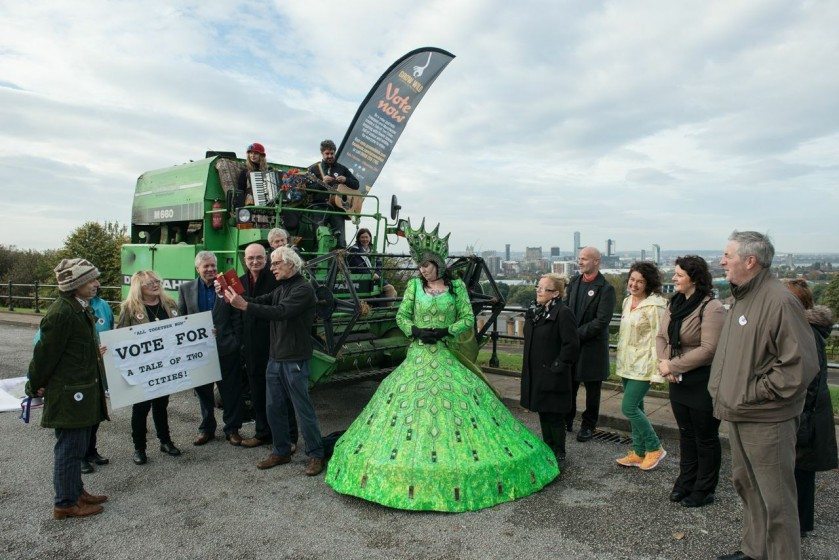
During the course of the campaign we canvassed and caroled museums, street markets and football matches to get enough popular votes to beat 4 other UK Cities to win the National prize. This will give us £120,000 prize to use wildflowers as the catalyst for a whole series of adventures in the spirit of creative conservation to allow other people to add their own experience and energy to those of the wildflowers themselves. Twenty football pitches of wildflowers in the the two cities. Football pitches are a significant measuring stick since we received support of past Liverpool football icon Kenny Dagliesh (King Kenny, who has 700,000 twitter followers), who tweeted his support from Liverpool’s John Lennon Airport. Although often the plant and football cultures don;t mix, Dagliesh’s Tweet immediately drew 39,000 people to our website. Mr Silky, the football skills star from the campaign, declared on the day after the vote that he was dreaming of flowers for the first time in his life.
A Tale of Two Cities will be cultural bridge between these two often-competitive places, with planting on prominent roadways and green spaces. The title for our bid came from the Charles Dickens novel, with its fitting opening line “It is the best of times It was the worst of times”, and measures up to the challenges of recession and government cuts, and times we live in. We’ll be working with performance poets and songwriters from both cities to form a collective contemporary narrative with multiple points of entry for people of all ages. This rich cultural element makes the wildflower project unique with cross thread literary links to Gerald Manley Hopkins, to Chinese classical and dub music, and modern songwriting talent, to celebrate the flowering and bring joy to both northern cities.
Seeding this project is believing in the potential held by a single seed, and the cost-effectiveness of using seeds well, as opposed to costly landscaping schemes. The deliberation over choosing and sowing particular species is key to giving nature a helping hand, speeding things up a bit, and loading the dice in our favour. Success is the both the wow factor and the longer-term impact of the bringing the wild in wildflower seeds into city life. Seeing is believing because when people observe these dramatic outcomes for themselves it changes perspectives and gives a new vision of what is possible. This is how such projects can develop a real legacy in changing the way we view the world, in translating the best fit for nature in urban places.
This story will form a springboard of practical effort for the World Conference of the Society for Ecological Restoration coming to Manchester this August to encourage ecological restorationists, planners and communities to leap off into new areas they might not have thought of before, meeting people from all walks of life, being educated by accident. We are still accepting abstracts on the theme of Resilience Ecology. Our conference title is Resilience Ecology: Restoring the Rural the Urban and the Wild.
For me, creative conservation gatherings have nourished and strengthened partnerships and practical actions. So I hope to see some of you in Manchester on 23-27 August 2015!
For further info on our work and projects please email [email protected].
Richard Scott
Liverpool


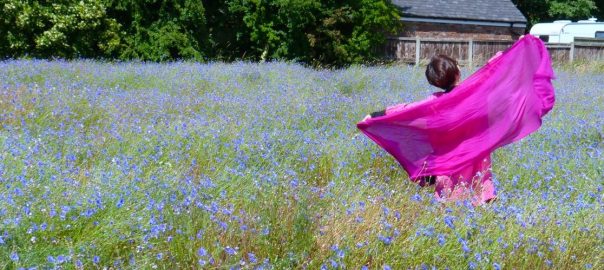

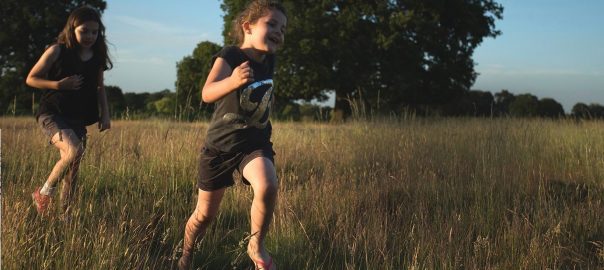
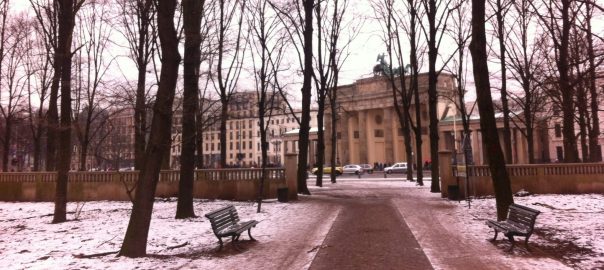
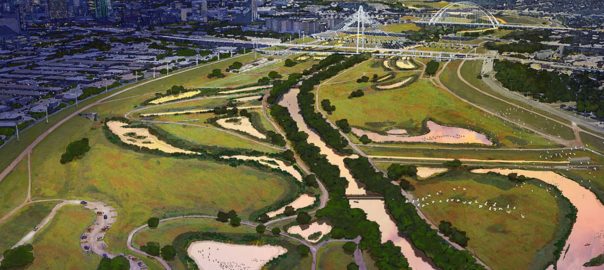
Leave a Reply